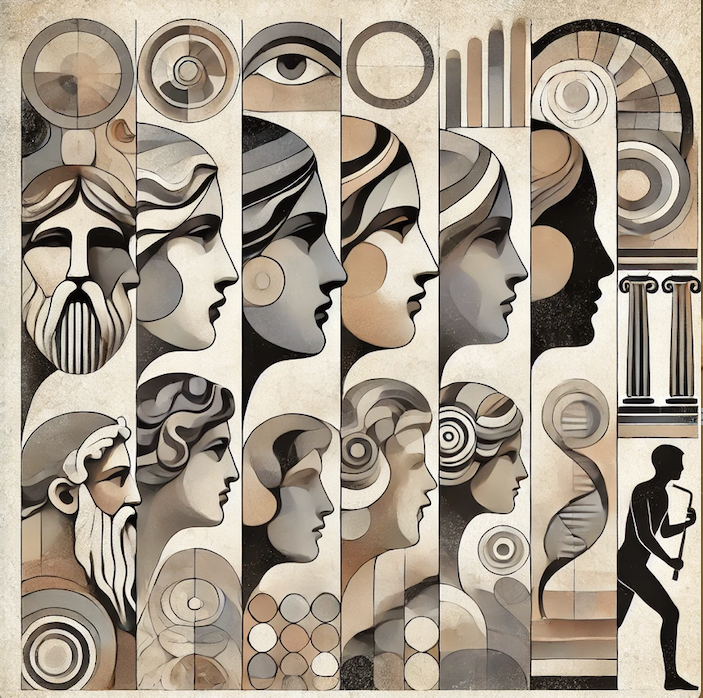- atelierpsychothera
- Jan 21
- 3 min read

The psychology of appearance has evolved significantly over centuries, reflecting cultural, scientific, and societal shifts. From ancient philosophical musings to modern psychological theories, the study of appearance has shaped and been shaped by human understanding of identity, beauty, and self-perception.
1. Ancient and Classical Periods
Body and Beauty in Philosophy: In ancient Greece and Rome, physical appearance was deeply linked to morality, virtue, and character. Philosophers like Plato and Aristotle associated beauty with harmony, symmetry, and inner goodness. This period saw the idealisation of the human form, celebrated in art and sculpture. Plato famously remarked, "Beauty lies in the eyes of the beholder," emphasising subjective perception.
Cultural Practices: Appearance was a marker of social status, religion, and cultural identity. Makeup, hairstyles, and clothing were used to signify roles within society.
2. Medieval and Religious Interpretations
Spiritual and Moral Overtones: During the medieval era, appearance was often viewed through a religious lens. Outer beauty was considered less important than inner virtue, though physical deformities were sometimes interpreted as signs of sin or divine punishment. St. Augustine observed, "Beauty is indeed a good gift of God; but that the good may not think it a great good, God dispenses it even to the wicked."
Global Practices: Beyond Europe, societies worldwide engaged in practices like tattooing, scarification, and adornment to signify spiritual beliefs and cultural identity.
3. Renaissance and Enlightenment
Humanism and Art: The Renaissance celebrated the human form as a pinnacle of divine creation. Artists like Leonardo da Vinci studied anatomy to depict physical perfection, blending science and art. As Shakespeare wrote, "Beauty is bought by judgment of the eye," reflecting the period's focus on perspective and personal evaluation.
Emerging Sciences: Early scientific exploration began examining physical traits in relation to personality and health. Theories like physiognomy emerged, suggesting that facial features could reveal character traits.
4. 19th Century: Early Scientific Approaches
Darwin and Evolution: Charles Darwin’s theories emphasised the role of appearance in natural and sexual selection, viewing physical traits as adaptive features. Darwin noted, "A beautiful form is better than a beautiful face; a beautiful behavior than a beautiful form."
Criminology and Physiognomy: Cesare Lombroso’s controversial theories linked facial features to criminal tendencies. While discredited today, these ideas reflected early attempts to connect appearance with behavior.
5. 20th Century: Modern Psychology of Appearance
Psychoanalytic Foundations: Sigmund Freud and others explored self-perception and body image in relation to identity and development.
Body Image Research: Paul Schilder’s 1935 book The Image and Appearance of the Human Body introduced the concept of body image, examining how individuals perceive their own bodies.
Social Psychology: Research revealed how appearance impacts social interactions, stereotypes, and self-esteem. Studies on the "halo effect" (you can read about it in of the previous articles) demonstrated how attractive individuals are often perceived more favourably in various contexts.
Media Influence: With the rise of mass media, the effects of beauty standards on self-perception became a significant focus. Advertising and cinema reinforced cultural ideals of beauty.
6. Late 20th and 21st Century: Expanding Perspectives
Feminist and Sociocultural Critiques: Scholars like Naomi Wolf challenged societal beauty norms, linking them to systemic issues like gender inequality (The Beauty Myth, 1990).
Inclusion and Diversity: Research broadened to include how race, ethnicity, gender identity, and disability influence experiences related to appearance.
Body Dysmorphic Disorder (BDD): Clinical psychology identified and treated disorders related to appearance, reflecting growing awareness of mental health issues.
Digital and Social Media: Social platforms and photo editing tools intensified scrutiny of appearance, sparking movements for body positivity and authenticity.
7. Emerging Trends
Neuroscience: Advances in brain imaging have deepened understanding of how the brain processes appearance, including facial recognition and perceptions of beauty.
Positive Psychology: Focus has shifted toward promoting self-acceptance and resilience against societal pressures.
Technological Impacts: Virtual reality and AI technologies continue to reshape how individuals interact with and perceive appearance, introducing both challenges and opportunities.
The psychology of appearance is a dynamic field that continues to evolve alongside cultural and technological advancements. Its rich history underscores the profound impact of appearance on individual identity, societal interactions, and mental health.




Comments